The Intel Xeon W-3175X Review: 28 Unlocked Cores, $2999
by Ian Cutress on January 30, 2019 9:00 AM ESTGaming: Grand Theft Auto V
The highly anticipated iteration of the Grand Theft Auto franchise hit the shelves on April 14th 2015, with both AMD and NVIDIA in tow to help optimize the title. GTA doesn’t provide graphical presets, but opens up the options to users and extends the boundaries by pushing even the hardest systems to the limit using Rockstar’s Advanced Game Engine under DirectX 11. Whether the user is flying high in the mountains with long draw distances or dealing with assorted trash in the city, when cranked up to maximum it creates stunning visuals but hard work for both the CPU and the GPU.
For our test we have scripted a version of the in-game benchmark. The in-game benchmark consists of five scenarios: four short panning shots with varying lighting and weather effects, and a fifth action sequence that lasts around 90 seconds. We use only the final part of the benchmark, which combines a flight scene in a jet followed by an inner city drive-by through several intersections followed by ramming a tanker that explodes, causing other cars to explode as well. This is a mix of distance rendering followed by a detailed near-rendering action sequence, and the title thankfully spits out frame time data.
| AnandTech CPU Gaming 2019 Game List | ||||||||
| Game | Genre | Release Date | API | IGP | Low | Med | High | |
| Grand Theft Auto V | Open World | Apr 2015 |
DX11 | 720p Low |
1080p High |
1440p Very High |
4K Ultra |
|
There are no presets for the graphics options on GTA, allowing the user to adjust options such as population density and distance scaling on sliders, but others such as texture/shadow/shader/water quality from Low to Very High. Other options include MSAA, soft shadows, post effects, shadow resolution and extended draw distance options. There is a handy option at the top which shows how much video memory the options are expected to consume, with obvious repercussions if a user requests more video memory than is present on the card (although there’s no obvious indication if you have a low end GPU with lots of GPU memory, like an R7 240 4GB).
All of our benchmark results can also be found in our benchmark engine, Bench.
| GTA V | IGP | Low | Medium | High |
| Average FPS | 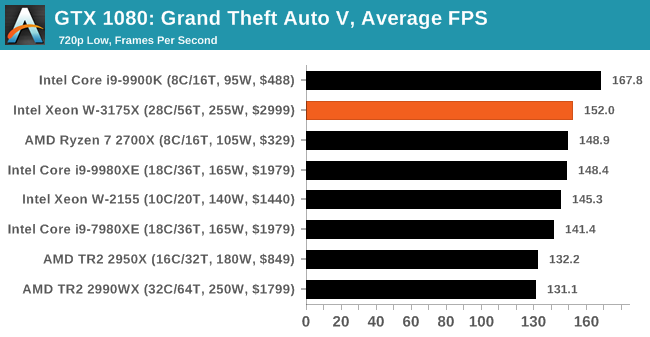 |
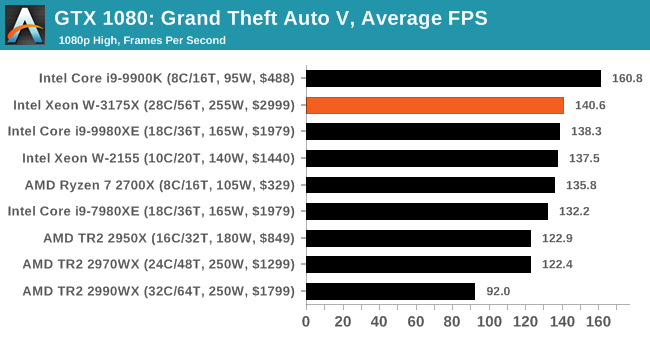 |
 |
 |
| 95th Percentile | 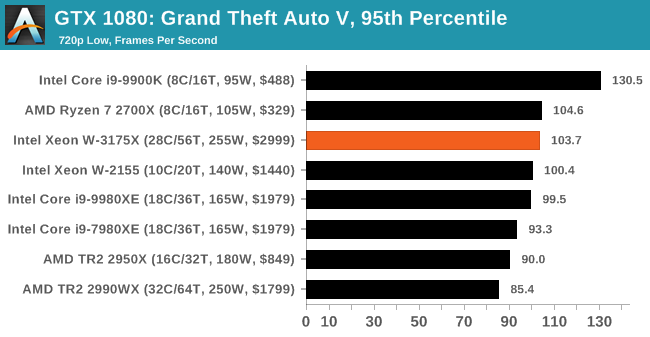 |
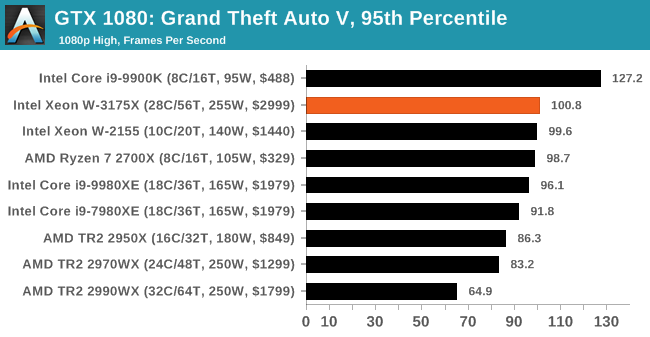 |
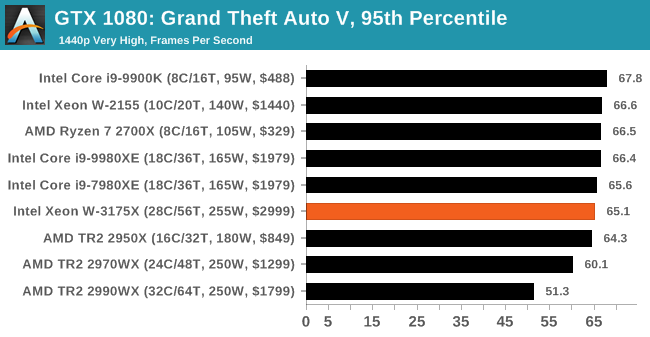 |
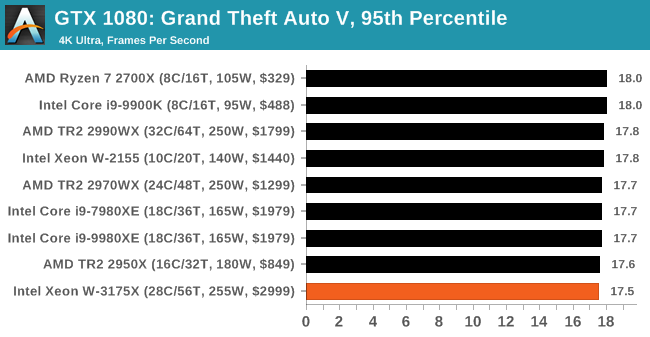 |
.












136 Comments
View All Comments
eastcoast_pete - Wednesday, January 30, 2019 - link
@Ian: Thanks for the review. I guess the "lower" price of this 28-core Xeon shows the benefit of having strong competition in the market - without the large Threadrippers, that price wouldn't have come down from the $ 8,000 mark.Two questions: I am still struck by how often the higher-end "consumer" grade CPUs beat the pants off the many-core monsters. Is high single-thread performance still that dominant in the applications in which the 9900K or 2700x lead the pack?
Second, did Intel really recommend to plug this monster directly into a wall outlet? If yes, wow. Guess you need a surge-protected, line-conditioned house line then, so not exactly standard equipment. Having encountered brownouts and voltage spikes, I wouldn't plug even a $ 500 PC straight into an unprotected household socket, never mind a $ 7,000 rig. I guess if that's what they recommend, it doesn't void the warranty when stuff happens.
My other comment is that this chip is really about workstation-type tasks, and while I know that coming up with more workstation-specific test suites is too specialized, that's where these Xeons and the big Threadrippers start making sense.
Regarding gaming: As you also hint at, much of that $ 3,000 budget for the CPU would be better spend on two or more high-end graphics cards (2080 GTX), all liquid cooling, a hand-selected eight core CPU, and a large, ultra-wide aspect fast refresh HDR-capable monitor.
zepi - Wednesday, January 30, 2019 - link
Ian is working in UK. He has most likely something like 230V single phase 80A feed-in to his house, if not 100 or even 120A, depending if he has electric heating or gas.One main fuse for that surely. Then that phase is split to some smaller circuits feeding into separate rooms & sockets etc. probably 8-16A fuses. Some stronger ones (30+A) if he has electric heaters in the taps / shower without using a boiler & heating circuits.
Then another fuse in each wall socket. And most likely a fourth fuse inside the actual cable.
And @230V, the cable "only" needs to support 7A, so it is actually nothing spectacular.
1500W devices are perfectly fine in Europe, mostly because of the 230V voltage. It just makes things much easier.
SaturnusDK - Wednesday, January 30, 2019 - link
Many if not most European households have 3 phase 230V 16A power, so you can power standard 400V appliances.BushLin - Wednesday, January 30, 2019 - link
In the UK a standard wall outlet is rated for 13A. Our kettles are nearly all 3KW. We value our tea and have built our homes around it.eastcoast_pete - Wednesday, January 30, 2019 - link
But then, your kettle doesn't require clean sine wave AC current, and won't suffer much if the voltage drops or spikes. In contrast, an expensive rig like this might. My comment wasn't about overall power need of this setup, but my surprise over the "unfiltered wall socket is fine" instruction from Intel.eastcoast_pete - Wednesday, January 30, 2019 - link
I am quite familiar with the situation in Europe. But, even there, I wouldn't just trust a regular power outlet (220 or 230 V) to provide clean sine power free from interference, voltage drops (brownouts) and voltage spikes, and neither do several friends of mine who live and work in Europe. They also use, at minimum, a good surge protector, and, for expensive systems, a UPS and line conditioner, just like we do here in the States.SaturnusDK - Thursday, January 31, 2019 - link
Surge protection is built into all regulatory fuse boxes so you don't need that in Europe since 2003 unless the building hasn't been updated to the current building code. Also before 2003 it was 220V in Europe and 240V in the UK. Now it's just 230V everywhere. Last there was a registered brown out in the area I live and work was February 1987... almost 32 years ago. In many areas of Europe it's not even worth considering as a risk anymore. You still need an UPS for obvious reasons though.maroon1 - Wednesday, January 30, 2019 - link
At least it is faster and has more consistence performance than 2990WX. Gaming performance also much better without the need to disable cores like you do for 2990WXtamalero - Wednesday, January 30, 2019 - link
I'm still scratching my head on who would buy this thing for "gaming" o_Oalacard - Wednesday, January 30, 2019 - link
Damn Ian you're on a roll with this on the heels of your incredible Intel's 10nm Cannon Lake and Core i3-8121U Deep Dive Review. Do you ever sleep?There's so much talent here that all you guys really should quit working for Purch and start your own independent tech site where the ads are reasonable and not exploitative. I can imagine everyone running straight to it and supporting it. Make it run on small ads and donations and you'd probably make out like kings.
Purch doesn't deserve you, period. Takes your talents elsewhere.